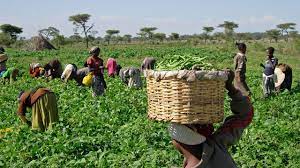Agricultural sector’s contribution to economy shrinks – NBS

Nigeria’s agricultural sector once regarded as the backbone of the economy, is now facing a significant decline, leading to a contraction in its contribution to the nation’s overall economic growth. Over the years, the country has been heavily dependent on oil exports, neglecting the potential of the agricultural sector. However, this negligence has led to a lack of investment, limited technological advancements, and insufficient infrastructure development, all of which have resulted in a decline in the sector’s productivity and output.
Taking inflation and deflation into account, the National Bureau of Statistics (NBS) reported that in the third quarter of 2023, the agriculture sector’s share of Nigeria’s GDP was 1.30 percent. The growth was down 0.04 percentage points from the same period in 2022 and down 0.20 percentage points from Q2 2023, when the growth rate was 1.50 percent, according to the NBS’s GDP report.
Read Also : From Idea to IPO: Startup Stories That Inspire
The low contribution is in spite of the fact that farmers harvest their produce in the third quarter, but high taxes imposed by non-state actors have continued to strain the nation’s food security. The sector, which is further broken down into the four activities of agriculture, forestry, fishery, and livestock production, contributed 29.31% in real terms to the GDP of the entire country in the third quarter of 2022, which was less than in the third quarter of 2022 but more than in the second quarter of 2023, when the contributions were 29.67% and 23.11%, respectively.
According to the NBS report, “Crop production remained the major driver of the sector. This is evident as it accounts for 92.24 per cent of the overall nominal value of the sector in the third quarter of 2023. Quarter-on-quarter growth stood at 45.59 per cent in the third quarter of 2023. Agriculture contributed 26.36 per cent to nominal GDP in the third quarter of 2023. This figure was lower than the rate recorded in the third quarter of 2022 and higher than the second quarter of 2023 which recorded 27.55 per cent and 21.07 per cent respectively.”







